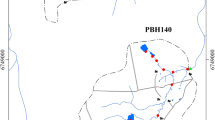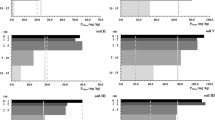Abstract
Purpose
The transfer of soil sediments and phosphorus from terrestrial to aquatic systems is a common process in agricultural lands. The aims of this paper are to quantify the soil phosphorus availability and to characterize phosphorus forms in soil sediments as contaminant agents of waters as a function of anthropic pressures.
Materials and methods
On three subwatersheds with different anthropic pressure, water and sediment samples were collected automatically in upstream and downstream discharge points in six rainfall events during the tobacco growing season. Phosphorus desorption capacity from soil sediments was estimated by successive extractions with anion exchange resins. First-order kinetic models were adjusted to desorption curves for estimating potentially bioavailable particulate phosphorus, desorption rate constant, and bioavailable particulate phosphorus.
Results and discussion
The amount of bioavailable particulate phosphorus was directly correlated with the iron oxide content. The value of desorption rate constant was directly related with the total organic carbon and inversely with the iron oxide contents. Phosphate ions were released to solution, on average, twice as rapidly from sediments collected in subwatersheds with low anthropic activity than from those ones of highly anthropic subwatersheds. Anthropic pressure on watershed can engender high sediment discharge, but these solid particles seem to present low phosphorus-releasing capacity to water during transport due to the evidenced high affinity between phosphorus and iron oxide from sediments.
Conclusions
Anthropic pressure was related with sediment concentration and phosphorus release to aquatic systems. While natural vegetation along streams plays a role on soil and water depuration, it is unable to eliminate the phosphorus inputs intrinsic to the agricultural-intensive systems.
Recommendations and perspectives The contamination of water in watershed by phosphates is facilitated by the erosion process and the traditional tobacco cropping system. Urgent measures for erosion control must be adopted, in accordance to conformations of landscape and the local inhabitants’ needs. Among them, those worth pointing out are the adoption of a conservation crop system, regeneration of riparian zone, and reduction of the phosphate doses added to soil for tobacco cultivation.



Similar content being viewed by others
References
Barrow NJ (1983) A mechanistic model for describing the sorption and desorption of phosphate by soil. J Soil Sci 34:733–750
Bigarella JJ (2003) Estrutura e origem das paisagens tropicais e subtropicais. Dissertation, University Federal of Santa Catarina
Bortoluzzi EC, Rheinheimer DS, Gonçalves CS, Pellegrini JBR, Zanella R, Copetti ACC (2006) Contaminação de águas superficiais por agrotóxicos em função do uso do solo numa microbacia hidrográfica de Agudo, RS. Rev Bras Eng Agric Ambient 10:881–887
Bortoluzzi EC (2004) Caracterização quali-quantitativa de sedimento fluvial oriundo da microbacia hidrográfica fumageira de Agudo, Rio Grande do Sul. CNPq Brasília (Technical report)
CEW-EH-Y (1995) Engineering and design: sedimentation investigations of rivers and reservoirs. In: Department of the Army, Ed. US Army Corps of Engineers, Washington: Manual no. 1110-2-4000
Comissão de Química e Fertilidade do Solo—CQFS-RS/SC (2004) Manual de adubação e de calagem para os estados do Rio Grande do Sul e Santa Catarina. SBCS/NRS, Porto Alegre
Correll DL (1998) The role of phosphorus in the eutrophication of receiving waters: a review. J Environ Qual 27:261–266
Dils MR, Heathwaite AL (1996) Phosphorus fractionation in hill slope hydrological pathways contributing to agricultural runoff. In: Anderson MG, Brooks SM (eds) Advances in hillslope processes. Wiley, New York, pp 229–251
Favre F, Jaunet AM, Pernes M, Badraoui M, Boivin P, Tessier D (2004) Changes in clay organization due to structural iron reduction in a flooded vertisol. Clay Miner 39:123–134
Gburek WJ, Sharpley AN (1998) Hydrologic controls on phosphorus loss from upland agricultural watersheds. J Environ Qual 21:30–35
Gonçalves CS, Rheinheimer DS, Pellegrini JBR, Kist SL (2005) Qualidade da água numa microbacia hidrográfica de cabeceira situada em região produtora de fumo. Rev Bras Eng Agric Ambient 49:391–399
Jordan-Meille L, Dorioz JM (2004) Soluble phosphorus dynamics in an agricultural watershed. Agron 24:237–248
Kaiser DR (2006) Nitrato na solução do solo e na água de fontes para consumo humano numa microbacia hidrográfica produtora de fumo. Dissertation, University Federal of Santa Maria
Koski-Vähälä J, Hartikainen H (2001) Assessment of the risk of phosphorus loading due to resuspended sediment. J Environ Qual 30:960–966
Leinweber P, Meissner R, Eckhardt KU, Seeger J (1999) Management effects on forms of phosphorus in soil and leaching losses. Eur J Soil Sci 50:413–424
Lowrence R, Altier LS, Williams RG, Inamdar SP, Bosch DD, Sheridian JM, Thomas DL, Hubbard RK (1998) The riparian ecosystem management model: simulator for ecological processes in riparian zones. In: Proceedings of the First Federal Interagency Hydrologic Modeling Conference, Las Vegas, NV, April 1998, vol I, pp 1.81–1.88
Mcdowell RW, Sharpley AN, Folmar G (2001a) Phosphorus export from an agricultural watershed: linking source and transport mechanisms. J Environ Qual 30:1587–1595
Mcdowell RW, Sharpley AN, Condron LM, Haygarth PM, Brookes PC (2001b) Processes controlling soil phosphorus release to runoff and implications for agricultural management. Nutr Cycl Agroecossyst 59:269–284
McKean SJ, Warren GP (1996) Determination of phosphate desorption characteristics in soils using successive resin extractions. Commun Soil Sci Plant Anal 27:2397–2417
Mehra OP, Jackson ML (1960) Iron oxide removal from soils and clays by a dithionite–citrate system buffered with sodium bicarbonate. In: Swinwford A (ed) Clays clay mineralogy. Pergamon, New York, pp 317–342
Minella JPG, Merten GH, Reichert JM, Rheinheimer DS (2007) Identificação e implicações para a conservação do solo das fontes de sedimentos em bacias hidrográficas. Rev Bras Cienc Solo 31:1637–1646
Murphy J, Riley JP (1962) A modified single solution method for the determination of phosphate in natural waters. Anal Chim Acta 27:31–36
Omernik JM (1977) Nonpoint source stream nutrient level relationships: a nationwide study. EPA Ecological Research Series. Corvallis Environmental Research Laboratory, US Environmental Protection Agency, Corvallis, 600/3-77-105
Parfitt RL (1989) Phosphate reactions with natural allophane, ferrihydrite and goethite. J Soil Sci 40:359–369
Pellegrini A (2006) Sistemas de cultivo da cultura do fumo com ênfase às práticas de manejo e conservação do solo. Dissertation, University Federal of Santa Maria
Reynolds CS, Davies PS (2001) Sources and bioavailability of phosphorus fractions in freshwaters: a British perspective. Biol Rev 76:27–64
Rheinheimer DS (2003) Caracterização física, química e biológica dos solos na microbacia hidrográfica do Arroio Lino, Nova Boemia, Agudo—RS. Ano II. Federal University of Santa Maria
Rheinheimer DS, Anghinoni I, Conte E (2003a) Sorção de fósforo em função do teor inicial e de sistemas de manejo de solos. Rev Bras Cienc Solo 27:41–49
Rheinheimer DS, Anghinoni I, Conte E, Kaminski J, Gatiboni LC (2003b) Dessorção de fósforo avaliada por extrações sucessivas em amostras de solo provenientes dos sistemas plantio direto e convencional. Cienc Rural 33:1053–1059
Rheinheimer DS, Pellegrini JBR, Gonçalves CS (2003c) Impacto das atividades agropecuárias na qualidade da água. Cien Amb 27:85–96
Rheinheimer DS, Bartz HR, Kaminski J, Willani SA (1991) Substituição do sulfato de potássio por cloreto na mistura de fertilizantes para a cultura do fumo. Agron Sulriogd 27:35–46
Robert M, Tessier D (1974) Méthode de préparation des argiles de sols pour les études minéralogiques. Ann Agron 25:859–882
Sharpley AN (1985) The selective erosion of plant nutrients in runoff. Soil Sci Soc Am J 49:1010–1015
Sharpley AN, Gburek WJ, Folmar G, Pionke HB (1999) Sources of phosphorus exported from an agricultural watershed in Pennsylvania. Agricult Water Manage 41:77–89
Sharpley AN, Hedley MJ, Sibbesen E, Hillbricht-Ilkowska AH, House WA, Ryszkowski L (1995) Phosphorus transfers from terrestrial to aquatic ecosystems. In: Tiessen H (ed) Phosphorus in the global environment. Wiley, Chichester, pp 171–200
Sharpley AN, Smith SJ, Jones OR, Berg WA, Coleman GA (1992) The transport of bioavailable phosphorus in agricultural runoff. J Environ Qual 21:30–35
Siemens J, Lang K, Kaupenjohann F (2004) Adsorption controls mobilization of colloids and leaching of dissolved phosphorus. Eur J Soil Sci 55:253–263
Soil Survey Staff (1999) Soil taxonomy: a basic system of soil classification for making and interpreting soil surveys, 2nd edn. US Department of Agriculture/Natural Resources Conservations Service, Washington 871 pp, Agriculture Handbook, 436
Tedesco MJ, Gianello C, Bissani CA, Bohnen H, Volkweiss SJ (1995) Análise de solo, plantas e outros materiais. University Federal of Rio Grande do Sul
Acknowledgements
This study was part of a project “Monitoramento Ambiental de Microbacias Hidrográficas” supported financially by the Secretaria da Agricultura e do Abastecimento do Estado do Rio Grande do Sul, Conselho Nacional de Desenvolvimento Científico e Tecnológico (CNPq), and Fundação de Amparo à Pesquisa do Estado do Rio Grande do Sul (FAPERGS). We thank CNPq for Research Fellowship to D.S. Rheinheimer and E.C. Bortoluzzi.
Author information
Authors and Affiliations
Corresponding author
Additional information
Responsible editor: Nicole Mathers
Rights and permissions
About this article
Cite this article
Pellegrini, J.B.R., dos Santos, D.R., Gonçalves, C.S. et al. Impacts of anthropic pressures on soil phosphorus availability, concentration, and phosphorus forms in sediments in a Southern Brazilian watershed. J Soils Sediments 10, 451–460 (2010). https://doi.org/10.1007/s11368-009-0125-6
Received:
Accepted:
Published:
Issue Date:
DOI: https://doi.org/10.1007/s11368-009-0125-6




